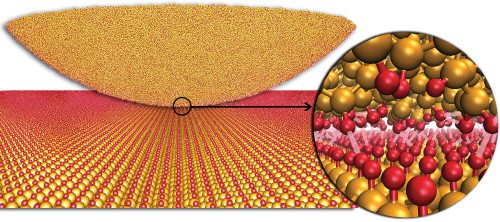
Physicists should “think big” when it comes to calculating the effects of friction on tiny nanomachines, according to researchers in the US, who say that they have strong evidence against the widely held belief that friction at the nanometre scale is different than friction in the everyday world.
Friction can be a big problem for small objects. Nanosized devices have very high surface-to-volume ratios, which means that their surfaces quickly wear out or even spontaneously stick together as they come into contact. To be able to control friction at the nanoscale, scientists have to first understand where friction comes from.
Current models of nanoscale friction assume that nanoscale surfaces are perfectly smooth, when in fact they are rough — rather like a mountain range, where peaks correspond to individual atoms or molecules. While physicists can use continuum mechanics to deal with the roughness of large objects, roughness on the nanoscale is tricky because it is not clear how individual atoms and molecules would interact with a sliding surface.
Collection of atoms
Now, Izabela Szlufarska and colleagues at the University of Wisconsin, Madison, have performed computer simulations that look at nanoscale materials as a collection of atoms (Nature 457 1116).
The researchers monitor the positions and interactions of the atoms as the materials slide across each other. This is the first time that atomistic simulations of sliding friction have shown quantitative agreement with experiments carried out on the same material systems — sliding diamond-like carbon atomic-force-microscope tips on hydrogen-terminated diamond surfaces, says Szlufarska.
Our discovery provides a new and simple framework for interpreting nanoscale friction experiments Izabela Szlufarska, University of Wisconsin, Madison
The team discovered that the force of friction is proportional to the number of atoms that interact between two nanoscale surfaces. This is much like friction between larger rough objects, where the friction is proportional to the total area of interaction between two surfaces.
“Our discovery provides a new and simple framework for interpreting nanoscale friction experiments, which up to now had been interpreted by continuum mechanics models,” Szlufarska said. “And, our demonstration that roughness theories also apply at the nanoscale provides a foundation for building unified friction laws across all length scales.”
The researchers would ultimately like to use their simulations to build quantitative theories of friction that would allow them to predict the coefficient of friction for given materials and experimental conditions.



